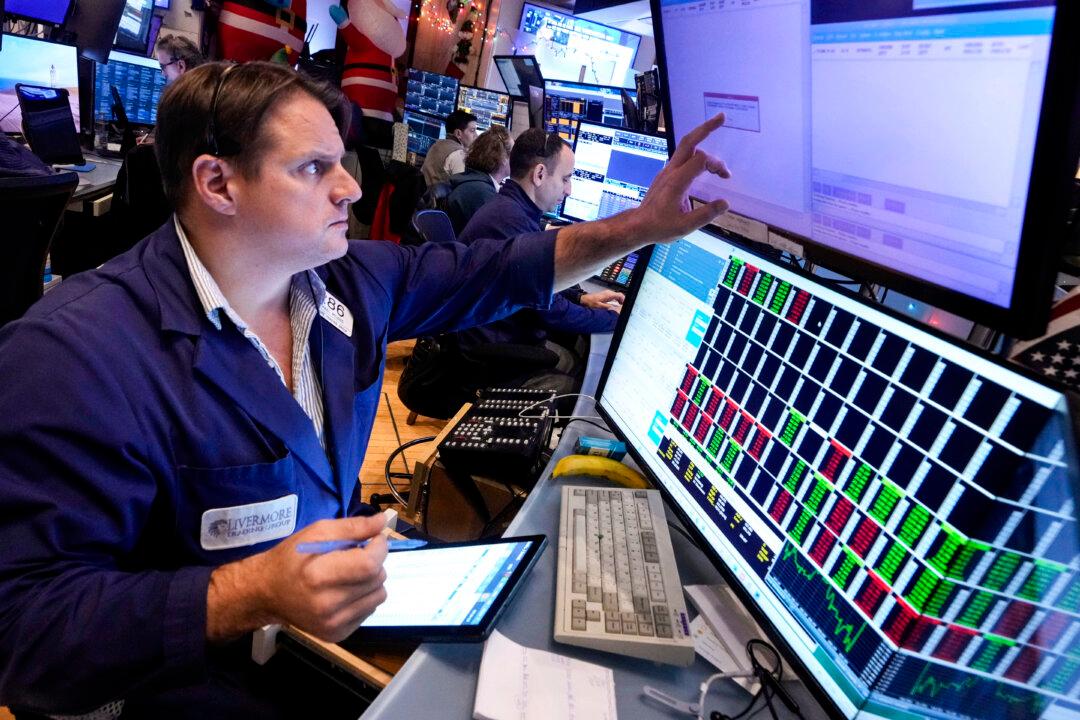U.S. Treasury investors were given a belated Christmas present in higher yields during the thin trading session on Thursday.
The 10-year Treasury yield rose above 4.64 percent on Dec. 26, the highest since May. The 20- and 30-year yields also inched higher to 4.87 percent and 4.78 percent, respectively.
Yields on short- and medium-term U.S. government bonds were also in a sea of green ink.
“There wasn’t any reason for the rise other than momentum combined with slow trading, but clearly the path of least resistance for Treasury yields is higher,” Tom Essaye, founder and president of Sevens Report Research, said in a note emailed to The Epoch Times.
Over the past few months, the upward trend in Treasury yields has led to various theories.
Since the long-awaited Federal Reserve pivot on monetary policy in September, Treasury yields have rocketed, with the benchmark 10-year rising to 1 percent.
After more than two years of inflation-fighting quantitative tightening—a blend of higher interest rates and balance sheet reduction—officials launched a new easing cycle with a jumbo half-point reduction to the 23-year high benchmark federal funds rate. They also indicated four rate cuts in 2025.
The financial markets might have signaled pessimism amid the divergence between rate cuts and rising Treasury yields—and they were correct.
The hawkish shift, says Federal Reserve Chair Jerome Powell, was fueled by higher inflation projections.
All three major inflation measures—the consumer price index (CPI), the producer price index (PPI), and the central bank’s preferred personal consumption expenditure (PCE) price index—have risen since the Fed’s September rate cut. Various forecasts expect they will tick up again next month.
The Fed’s quarterly survey highlighted that officials believe inflation will finish at 2.5 percent next year.
One economist told The Epoch Times that inflation could end 2025 at a higher level.
Connor Lokar, senior forecaster at ITR Economics, projects that the annual inflation rate will be 3.2 percent by the end of 2025. Government spending, federal deficits, and money-supply expansion will drive this increase, he said.
“So essentially higher inflation outcomes for next year relative to where we’re going to finish this year [are] somewhere below 3 percent and then moving higher than that as we move through 2026,” Lokar stated in an interview.

As a result, the Fed could take the stairs down to normalization rather than hopping on the elevator, says Joe Tigay, portfolio manager at Catalyst Insights.
“If inflation persists at manageable levels, the Fed will likely allow interest rates to normalize gradually,” Tigay said in a note emailed to The Epoch Times. “This environment sets the stage for a steepening yield curve, which historically signals rising volatility.”
That said, the Fed chief dismissed assertions that markets are fighting against the central bank’s actions and forecasts, stating that rates can be affected by more than just monetary policy.
Essaye agrees, writing that several contributors to the acceleration in yields could include budget deficit concerns, pro-growth expectations, and political anxiety over the next four years.
Looking ahead, the U.S. bond market “is now one ‘hot’ economic report away from testing the highs for 2024,” he said.
“If those highs are tested and broken, expect the headwind from higher yields on stocks to increase (which means more stock volatility),” Essaye said.
Wall Street digested pre-Christmas employment data on Thursday.
Continuing jobless claims—a gauge of unemployed individuals receiving unemployment benefits—jumped by 46,000 to a three-year high of 1.91 million. The four-week jobless claims average, which removes week-to-week volatility, increased to 226,500.
The next major economic report will be the December jobs report on Jan. 10, 2025. Early estimates suggest that the U.S. economy created 200,000 new jobs and that the unemployment rate rose to 4.3 percent. The November non-farm payrolls report confirmed 227,000 new positions and a 4.2 percent jobless rate.







